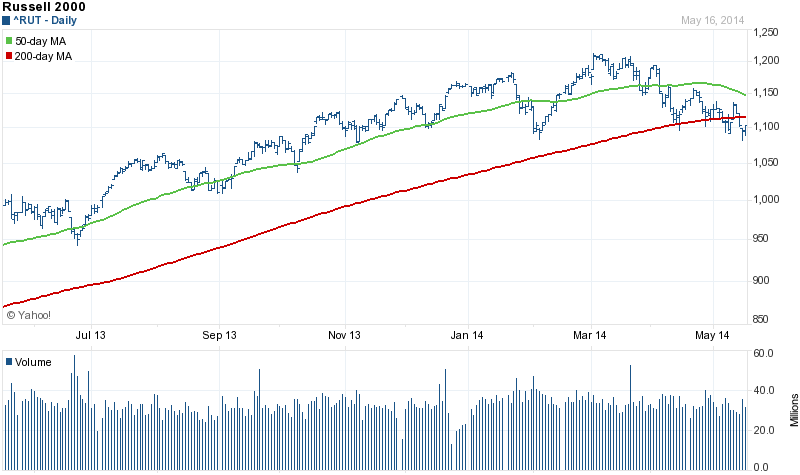Since the Great Recession of 2008 and 2009, in our opinion investment advisers have moved away from the traditional “buy-and-hold” strategy to a more tactical approach when it comes to managing clients’ assets. This market commentary provides some of the tactical views on global financial markets under our Adaptive Investment (TM) framework to help advisers to achieve consistent returns while limiting downside risks.
In mid-May, the Russell 2000 Index (RUT) at one point fell 8.75% from recent peak of 1,208.65 reached on March 4. On May 15, the index once fell below 1,087.79 during intra-day trading, the 10% threshold of the widely-used definition of correction, two days after the Dow Jones Industrial Average (DJIA) and the S&P 500 Index (SPX) closed at record highs.
The Russell 2000 index is also trading below its 50-day and 200-day moving averages. The technical analysts normally consider such an index in a downward trend trajectory.
Are small cap stocks in a correction? We think that small cap stocks might go lower in the near term. However, and we have no way of knowing for sure, in our opinion the bull market sentiment among investors, solid economic performance and monetary stimulus will continue moving small cap stocks and the overall stock market generally higher this year. There are a few factors that have contributed to the recent pullback of small cap stocks.

Source: Yahoo
Stretched Valuation: After a blistering rally last year, the valuation the of small cap stocks has moved above historical averages. At the end of 2013, the forward P/E ratio of Russell 2000 Index stood at 30, higher than the 18-year historical average of 26 since 1996, according to Bloomberg data.
The price-to-book ratio of small caps was 2.33, which was much higher than the historical average of 2.1 as well. After the earnings were revised up in 2014, the current forward PE and PB are 24.9 and 2.4, respectively. Although the valuation is not over-stretched, some correction in small cap stocks is inevitable, and healthy.

Source: Bloomberg
Weak Q1 Earnings Reports: On the earnings side, the most recent quarter has seen some disappointed earning reports. The Thomson Reuters index of nearly 2,000 companies in the small- and mid-cap space showed 44% have missed earnings forecasts so far, according to StarMine data.
In comparison, the large-cap companies had a better earning season. Just 25% of S&P 500 components have missed expectations for per-share earnings in the first quarter.
These technical and valuation data points suggest that the correction in small cap stocks may go a little further. However, the bull market in U.S. equities isn’t over yet. The positive trends in the broader markets are continuing, and the Federal Reserve keeps stimulus in place with a slow unwinding of quantitative easing.
U.S. Federal Reserve Chairwoman Janet Yellen stated that the central bank must continue to spur economic growth as indicators for inflation and employment remain far from the central bank’s goals. Most the economic indicators are pointing to the direction of an expanding economy. As the economic growth continues, corporate earnings growth will pick up. As a result, the valuation in the small cap stocks may not seem so expensive. We expect small cap stocks to be higher by the end of year.
DISCLAIMER: The investments discussed are held in client accounts as of April 30, 2013. These investments may or may not be currently held in client accounts. The reader should not assume that any investments identified were or will be profitable or that any investment recommendations or investment decisions we make in the future will be profitable. Past performance is no guarantee of future results.

